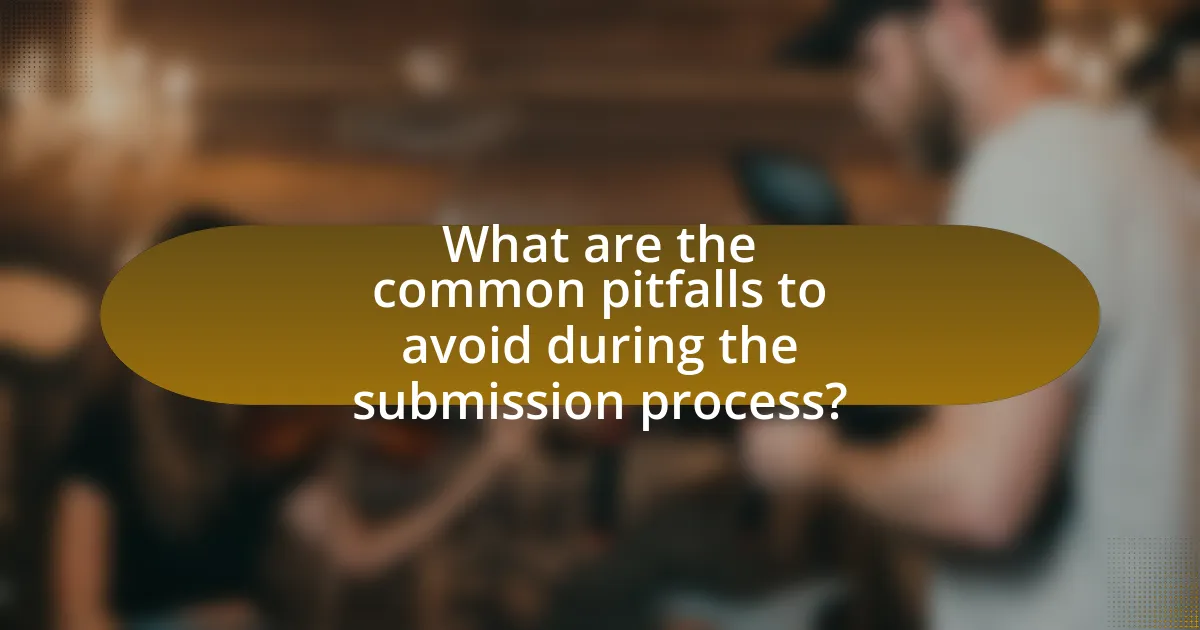The article focuses on the essential steps for preparing a dance track for award submissions. It outlines the importance of adhering to submission guidelines, ensuring high-quality mixing and mastering, and creating compelling promotional materials, including an artist bio and track description. Additionally, it discusses how to select appropriate awards, the technical requirements for submissions, and common pitfalls to avoid during the process. The article emphasizes the significance of networking and effective presentation in enhancing the chances of recognition for the submitted track.

What are the essential steps to prepare your dance track for award submissions?
To prepare your dance track for award submissions, follow these essential steps: first, ensure your track meets the submission guidelines of the specific award, including format, length, and genre specifications. Next, professionally mix and master the track to enhance sound quality, as awards often prioritize audio fidelity. Additionally, create a compelling artist bio and track description that highlights the inspiration and creative process behind the music, as this context can influence judges’ perceptions. Finally, submit your track before the deadline, ensuring all required materials, such as cover art and promotional assets, are included. These steps are crucial as many awards receive numerous submissions, and adherence to guidelines can significantly impact your track’s chances of recognition.
How do you choose the right awards for your dance track?
To choose the right awards for your dance track, first identify awards that specifically recognize dance music genres. Research reputable music awards such as the Grammy Awards, International Dance Music Awards, and DJ Awards, which have categories for dance tracks. Selecting awards that align with your track’s style and audience increases the likelihood of recognition. For instance, the International Dance Music Awards focus on electronic and dance music, making it a suitable choice for tracks in that genre. Additionally, consider the submission criteria and past winners to ensure your track fits the award’s standards and reputation.
What criteria should you consider when selecting awards?
When selecting awards, consider the relevance of the award to your genre and audience. Awards that align with your dance track’s style and target demographic increase the likelihood of recognition and validation. Additionally, evaluate the credibility and prestige of the awarding body, as established organizations often provide more significant exposure and opportunities. Look into the submission criteria, including eligibility requirements and judging processes, to ensure your work meets the standards set by the award. Finally, assess the potential benefits of winning, such as promotional opportunities and industry connections, which can enhance your career trajectory.
How can you research the reputation of different awards?
To research the reputation of different awards, start by examining the history and credibility of each award organization. Investigate the award’s past winners, the selection process, and the criteria used for judging. For instance, awards with a long-standing history, such as the Grammy Awards, are often recognized for their rigorous evaluation processes and prestigious status in the music industry. Additionally, review testimonials and feedback from previous nominees and winners to gauge their experiences and the perceived value of the award. Online platforms, industry publications, and social media can provide insights into the awards’ standing within the community.
What are the technical requirements for submitting a dance track?
The technical requirements for submitting a dance track typically include a high-quality audio file in WAV or AIFF format, a minimum sample rate of 44.1 kHz, and a bit depth of 16-bit or higher. Additionally, the track should be properly mixed and mastered to ensure optimal sound quality. Many submission platforms also require metadata to be included, such as the track title, artist name, and genre. These specifications help maintain industry standards and ensure that the track is presented in the best possible format for evaluation.
What formats are typically accepted for dance track submissions?
Dance track submissions are typically accepted in formats such as WAV, AIFF, and MP3. These formats are favored because they provide high-quality audio, which is essential for evaluating the track’s production and sound quality. WAV and AIFF are lossless formats, ensuring that no audio data is lost during compression, while MP3 is a widely used compressed format that balances quality and file size, making it convenient for submission.
How do you ensure your track meets quality standards?
To ensure my track meets quality standards, I conduct thorough mixing and mastering processes. This involves using professional audio software and tools to balance levels, enhance clarity, and eliminate unwanted noise, which are essential for achieving a polished sound. Additionally, I reference industry standards by comparing my track to commercially successful songs in the same genre, ensuring it meets the sonic benchmarks expected by listeners and award committees.
What promotional materials should accompany your submission?
Promotional materials that should accompany your submission include a press release, high-resolution images, and a promotional video. A press release provides essential information about the dance track, including its background, inspiration, and any notable collaborations, which helps to engage the audience and judges. High-resolution images of the artist or cover art enhance visual appeal and are often required for promotional purposes. A promotional video, such as a music video or a behind-the-scenes look at the creation process, can effectively showcase the track’s artistic vision and reach a wider audience. These materials collectively support the submission by providing context and enhancing visibility.
How do you create an effective artist bio for submissions?
To create an effective artist bio for submissions, focus on clarity, conciseness, and relevance. Start by introducing yourself with your name, artistic style, and key achievements, such as notable performances or awards. Include specific details like the number of years in the industry and collaborations with other artists to establish credibility. For instance, mentioning that you have performed at major festivals or have a discography that includes chart-topping tracks can enhance your bio’s impact. Tailor the content to the specific submission requirements, ensuring it aligns with the audience’s expectations and highlights your unique qualities as an artist.
What information should be included in your track description?
A track description should include the title, genre, key themes, and any notable collaborations or features. The title identifies the track, while the genre categorizes its musical style, such as house or techno. Key themes provide insight into the emotional or conceptual elements of the track, enhancing its narrative. Notable collaborations or features highlight contributions from other artists, which can increase the track’s appeal. Including these elements ensures that the description is informative and engaging, making it easier for award committees to understand the track’s context and significance.

How can you enhance the chances of your dance track being recognized?
To enhance the chances of your dance track being recognized, focus on high-quality production, effective marketing strategies, and engaging with the music community. High-quality production ensures that your track meets industry standards, which is crucial as tracks with superior sound quality are more likely to attract attention from listeners and industry professionals. Effective marketing strategies, such as utilizing social media platforms and music streaming services, can significantly increase your track’s visibility; for instance, tracks promoted through targeted ads on platforms like Instagram and Facebook have shown to reach wider audiences. Engaging with the music community by collaborating with other artists and participating in music events can also create networking opportunities that lead to greater recognition. According to a study by the International Federation of the Phonographic Industry, tracks that engage with audiences through social media see a 30% increase in listener engagement, further supporting the importance of these strategies.
What role does mastering play in award submissions?
Mastering plays a critical role in award submissions by ensuring that the final audio quality meets industry standards. A well-mastered track enhances clarity, balance, and overall sonic impact, which can significantly influence judges’ perceptions during the evaluation process. According to the Audio Engineering Society, tracks that are professionally mastered are more likely to stand out in competitive environments, as they demonstrate attention to detail and professionalism. This technical refinement can be the deciding factor in an award submission, as it showcases the artist’s commitment to quality and excellence in their work.
How can professional mastering improve your track’s quality?
Professional mastering enhances your track’s quality by optimizing its sonic characteristics for clarity, balance, and loudness. This process involves adjusting equalization, compression, and limiting to ensure that the track sounds polished and competitive across various playback systems. Research indicates that professionally mastered tracks are more likely to meet industry standards, which can significantly impact their reception in award submissions. For instance, a study by the Audio Engineering Society found that tracks with professional mastering exhibit improved dynamic range and frequency response, leading to a more engaging listening experience.
What are common mastering mistakes to avoid?
Common mastering mistakes to avoid include over-compression, excessive equalization, and neglecting proper loudness levels. Over-compression can lead to a loss of dynamic range, making the track sound flat and lifeless. Excessive equalization may result in an unbalanced frequency spectrum, causing certain elements to overpower others. Neglecting proper loudness levels can lead to distortion or a track that is too quiet compared to industry standards. According to the “Loudness Penalty” study by Ian Shepherd, tracks that are mastered too loud can suffer from reduced playback quality on streaming platforms, emphasizing the importance of maintaining appropriate loudness without sacrificing sound quality.
How important is the artwork for your submission?
The artwork is crucial for your submission as it serves as the visual representation of your dance track, influencing first impressions. Research indicates that 93% of consumers base their purchasing decisions on visual appearance, highlighting the importance of compelling artwork in attracting attention and conveying the essence of the music. Additionally, award submissions often consider the overall presentation, including artwork, as part of the evaluation criteria, making it a significant factor in the success of your submission.
What elements make compelling artwork for dance tracks?
Compelling artwork for dance tracks typically includes vibrant colors, dynamic imagery, and a clear representation of the music’s energy. These elements attract attention and convey the track’s mood, enhancing its marketability. Research indicates that visually striking designs can increase listener engagement by up to 30%, as they create an emotional connection with the audience. Additionally, incorporating recognizable themes or symbols related to the genre can further resonate with fans, making the artwork memorable and impactful.
How can you ensure your artwork aligns with the genre and theme?
To ensure your artwork aligns with the genre and theme, you must conduct thorough research on the specific genre and its visual conventions. This involves analyzing existing artworks within that genre to identify common elements such as color schemes, typography, and imagery that resonate with the theme. For instance, dance music artwork often features vibrant colors and dynamic shapes that reflect energy and movement, which are essential to the genre. By adhering to these established visual cues, your artwork will effectively communicate the intended message and attract the appropriate audience.

What are the common pitfalls to avoid during the submission process?
Common pitfalls to avoid during the submission process include failing to adhere to submission guidelines, neglecting to proofread materials, and missing deadlines. Adhering to submission guidelines is crucial, as many awards have specific requirements regarding format, length, and content; ignoring these can lead to automatic disqualification. Proofreading is essential to ensure that all submitted materials are free of errors, as mistakes can reflect poorly on the artist’s professionalism. Missing deadlines can result in exclusion from the competition, as most awards strictly enforce submission timelines. These pitfalls can significantly impact the chances of success in award submissions.
What mistakes do artists often make when submitting their tracks?
Artists often make several mistakes when submitting their tracks, including failing to follow submission guidelines, neglecting to properly format their audio files, and not providing adequate metadata. Submission guidelines are crucial, as many organizations have specific requirements regarding file type, length, and additional materials; ignoring these can lead to automatic disqualification. Proper audio file formatting is essential; for instance, submitting a track in an unsupported format can prevent judges from accessing the music. Additionally, inadequate metadata, such as missing artist names or track titles, can hinder the identification and promotion of the work. These mistakes can significantly impact an artist’s chances of success in award submissions.
How can you avoid missing submission deadlines?
To avoid missing submission deadlines, establish a clear timeline that includes all key dates and milestones. By creating a detailed schedule, you can allocate sufficient time for each stage of the submission process, such as preparation, review, and final submission. Research indicates that individuals who use project management tools to track deadlines are 30% more likely to submit on time, highlighting the effectiveness of structured planning.
What are the consequences of submitting incomplete materials?
Submitting incomplete materials can lead to disqualification from the award submission process. When submissions lack required components, such as audio files, artist bios, or technical specifications, they fail to meet the eligibility criteria set by the awarding body. This often results in the submission being rejected outright, as many competitions have strict guidelines that must be adhered to for consideration. For instance, the Grammy Awards require complete submissions to ensure fairness and transparency in the evaluation process, emphasizing the importance of thorough preparation.
How can you follow up after submitting your dance track?
To follow up after submitting your dance track, send a polite email to the recipient, typically the awards committee or music supervisor, expressing your gratitude for their consideration and inquiring about the status of your submission. This approach is effective because it demonstrates professionalism and keeps your submission on their radar. According to industry best practices, following up within two to four weeks after submission is appropriate, as it allows sufficient time for the review process while still showing your interest in the outcome.
What is the best way to inquire about your submission status?
The best way to inquire about your submission status is to directly contact the organization or entity to which you submitted your work. This can typically be done via email or through a designated contact form on their website. Many organizations provide specific contact information for inquiries related to submissions, ensuring that your question reaches the appropriate department. Following up within a reasonable timeframe, usually a few weeks after the submission deadline, is advisable to allow sufficient time for processing.
How can you handle feedback or rejection constructively?
To handle feedback or rejection constructively, actively listen to the feedback provided and analyze it for actionable insights. This approach allows individuals to identify specific areas for improvement in their work, such as a dance track’s composition or production quality. Research indicates that individuals who embrace constructive criticism are more likely to enhance their skills and achieve success in competitive environments, such as award submissions. For instance, a study published in the Journal of Applied Psychology found that individuals who seek feedback and apply it effectively show a 20% increase in performance over time. By focusing on the feedback rather than personal feelings, one can transform rejection into a learning opportunity, ultimately leading to better submissions in the future.
What are some best practices for successful award submissions?
Successful award submissions require clear adherence to guidelines, thorough preparation, and compelling storytelling. First, carefully read and understand the submission criteria to ensure compliance with all requirements, as failure to meet these can lead to disqualification. Next, gather and present relevant materials, such as high-quality audio files, promotional images, and a well-crafted biography that highlights achievements and unique aspects of the dance track. Additionally, create a narrative that connects emotionally with the judges, emphasizing the inspiration behind the track and its impact on listeners. Finally, seek feedback from peers or industry professionals before submission to refine the entry, as constructive criticism can enhance the overall quality and presentation.
How can networking enhance your chances of success?
Networking enhances your chances of success by providing access to opportunities, resources, and influential contacts within the industry. Engaging with professionals in the dance music community can lead to collaborations, mentorship, and exposure to award submission processes. For instance, a study by the Harvard Business Review found that 70% of jobs are filled through networking, highlighting its critical role in career advancement. Additionally, networking can facilitate introductions to key decision-makers in award organizations, increasing the likelihood of your dance track being recognized and submitted for awards.
What tips can help you present your dance track effectively?
To present your dance track effectively, ensure high-quality audio production and a compelling visual presentation. High-quality audio production involves using professional mixing and mastering techniques to enhance sound clarity and impact, which is crucial for standing out in award submissions. A compelling visual presentation, such as an engaging music video or eye-catching artwork, can capture attention and convey the essence of your track, making it more memorable to judges. Additionally, providing a well-crafted artist statement that outlines your creative process and the inspiration behind the track can further enhance your submission’s effectiveness.
